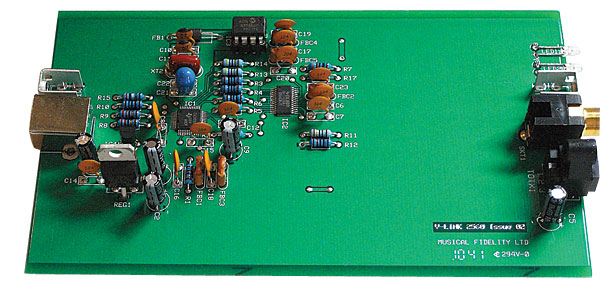| Columns Retired Columns & Blogs |
The M2Tech Hiface at $150 seems like an obvious comparison. It is also asynch, but goes up to 192 KHz. Any comparison of it with the V-Link?

Time for some more relevant comparisons. My testing had shown that the expensive dCS Debussy did have excellent rejection of jitter on both its serial (S/PDIF and AES/EBU) and USB inputs, so I changed to the Benchmark DAC1, again feeding the amplifiers directly, without a preamp. The Benchmark uses an asynchronous sample-rate converter ahead of its D/A chips, which should render it immune to datastream jitter. Paradoxically, however, I have found the DAC1 to be more sensitive to source components than you'd expect, so perhaps it would be more revealing of differences between the USB-S/PDIF converters I had to hand. (To be fair to Benchmark, my DAC1 is a first-generation sample, without any of the subsequent component upgrades.)
Well, that was the theory. First up was the Stello U2 ($349). The only problem I had with the U2 was that it didn't work transparently with audio files sampled at 88.2kHz, but it otherwise sounded excellent. With the Stello feeding the Benchmark via 1.5m of Stereovox coax and Pure Music playing the 1994 remastering of Sir John Barbirolli conducting the Royal Philharmonic in Sibelius's Symphony 2 (Apple Lossless files, ripped from CD, Chesky CG903), this half-century-old recording sounded full, with the wind choirs at the start set well back in the rich acoustic of Walthamstow Town Hall (a venue in which I have both performed and at which I've attended orchestral recording sessions). Perhaps the flurrying violins sounded very slightly more steely than they should have, but the pizzicato sections in the first movement had just the right amount of punch.
I then changed to the V-Link, had it feed the Benchmark via a 1m length of AudioQuest Optilink-5 glass TosLink cable, and did not touch the Benchmark's volume control. The violins in the Sibelius were now slightly less steely, the soundstage a tad wider and deeper. More important, the sounds of individual instruments, such as the horns at the start of the first movement, and the timpani and plucked double basses at the start of the second, were slightly more of a piece with the surrounding acoustic. The Stello is very good, but the V-Link was just that bit better. And yes, I know—I was using a $450 TosLink cable with the $169 V-Link. So I changed to the 15' length of generic plastic TosLink I use for my lab testing, which cost around 10 bucks. Darned if the sound of the Musical Fidelity wasn't degraded a little, though overall it was still ahead of the Stello.
The final comparison was with the Halide S/PDIF Bridge. This had the advantage over the Musical Fidelity in that its integral BNC output could be fastened directly to the Benchmark's BNC input jack, and its integral USB cable obviates the need for that item. The V-Link was still connected to the DAC1 with the plastic TosLink but, of course, was being used with the AudioQuest Coffee USB cable ($325, footnote 2).
Well, as much I would have liked to say that the $169 V-Link equaled the $450 Halide, with the Sibelius symphony the Halide did provide a slightly more transparent window on the Walthamstow Town Hall acoustic, with slightly more precisely defined stereo imaging. (Although, if I had to swear, the Halide's bass sounded a little less rich.) Reverting to the expensive glass AudioQuest TosLink did even matters up, the V-Link still sounding slightly richer than the Halide and the Halide still ahead in precision and transparency. But these are small differences in absolute terms—and with a DAC that offers better jitter rejection than the Benchmark, those differences may well vanish.
Summing Up
Overall, and especially considering its price, the Musical Fidelity V-Link seems a well-engineered solution to get USB audio data from a PC with minimal jitter. It operates in asynchronous mode as advertised, with both PCs and Macs, and gave first-rate sound quality with all the D/A processors I had to hand, especially with 24-bit/96kHz files. Though the V-Link won't handle 176.4 or 192kHz files, it did correctly handle 88.2kHz data, which I found a boon—all of my own hi-rez recordings are made at that sample rate, as are many of those engineered by Philip Hobbs for Linn Records' excellent series of classical downloads.
With the V-Link's price of just $169, it becomes difficult to justify recommending other USB-S/PDIF converters, though you do have to factor in the costs of USB and TosLink cables when comparing it, for example, with the Halide S/PDIF Bridge. Even so, Musical Fidelity's V-Link should justifiably sell like hotcakes to those with legacy DACs who want to use a PC as a server.

The M2Tech Hiface at $150 seems like an obvious comparison. It is also asynch, but goes up to 192 KHz. Any comparison of it with the V-Link?

What %age of products reviewed are from non-advertisers?
What %age of other than breathlessly positive reviews come from advertisers?

"What %age of products reviewed are from non-advertisers?"
The last time I did an analysis, in 2007, 53% of products reviewed in Stereophile were made by companies that didn't advertise (see the second footnote at the linked article). The proportion is not different today, as far as I can tell.